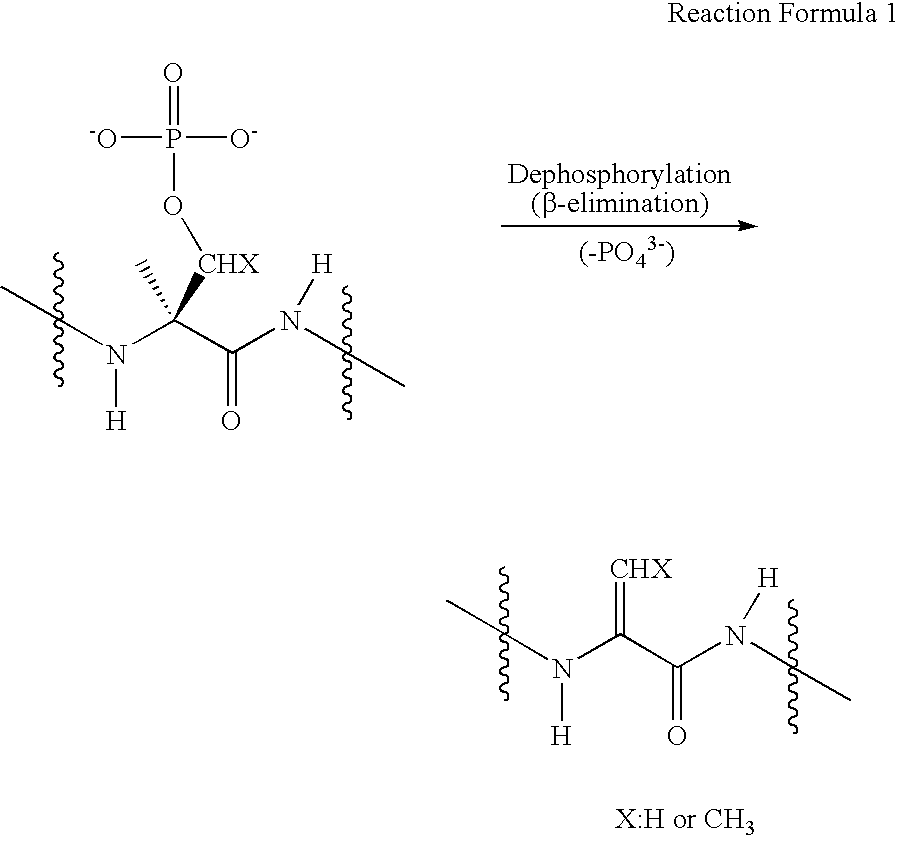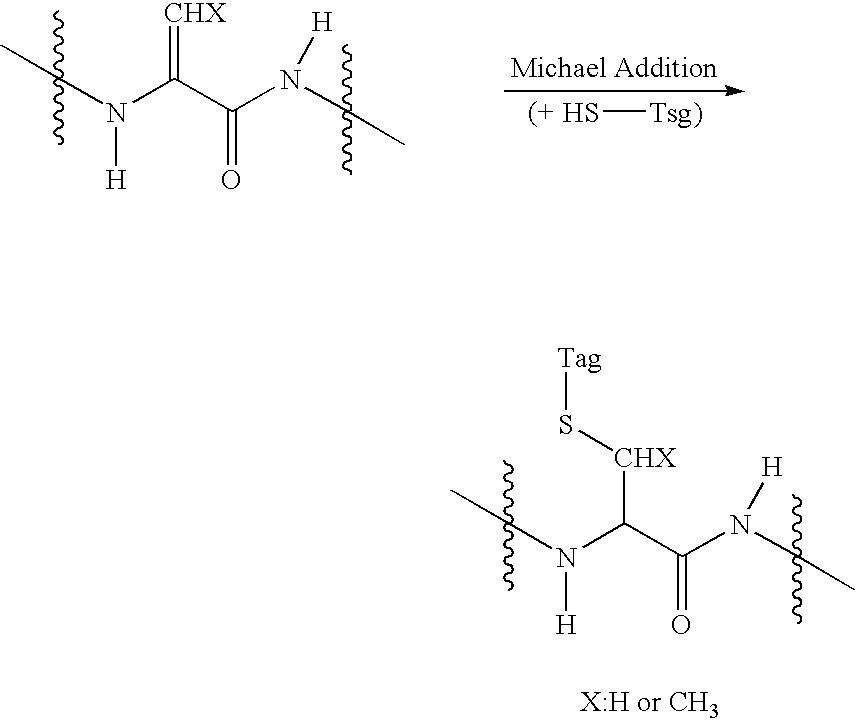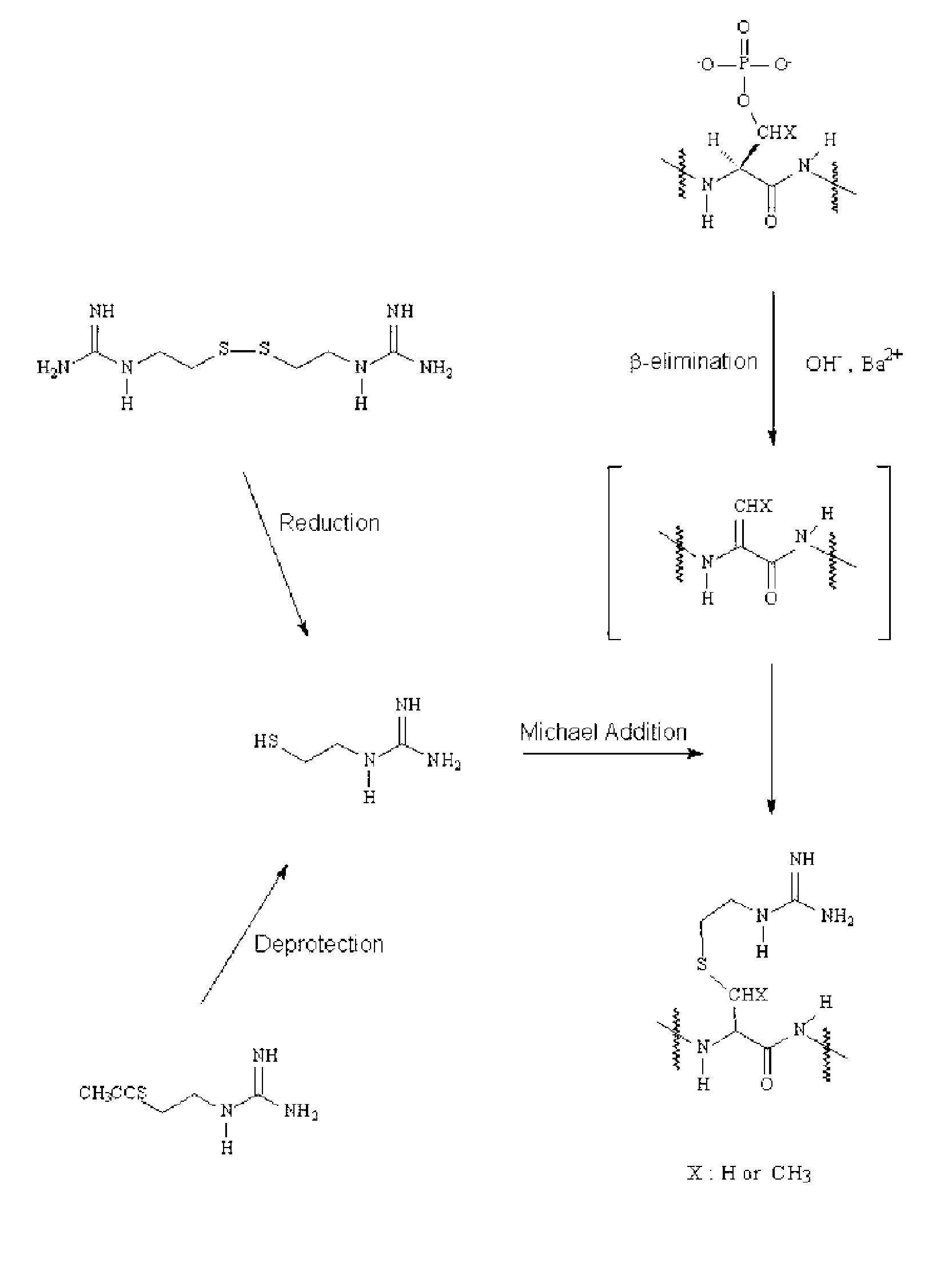Selective labeling agent for phosphoproteome analysis and phosphorylated site analysis
a phosphoproteome and labeling agent technology, applied in the direction of instrumentation, assay labels, peptide/protein ingredients, etc., can solve the problems of reducing the detection sensibility, reducing the detection sensitivity of phosphopeptides, and suffering from the disadvantages of tandem mass spectrometry in analyzing phosphopeptides. achieve the effect of high detection sensitivity
- Summary
- Abstract
- Description
- Claims
- Application Information
AI Technical Summary
Benefits of technology
Problems solved by technology
Method used
Image
Examples
example 1
[0056] Sample Preparation
[0057] For the convenience purification, a standard protein or a protein exacts to be analyzed was pre-treated according to well-known methods. A protein sample was denatured in 6M guanidine hydrochloride and then, allowed to contact with TCEP (Tris(2-carboxyethyl)phosphine) HCl for 1 hour at 37° C. to reduce the disulfide bonds of cystein residues. Reduced cystein residues were protected by use of an alkylating reagent such as iodoacetamide or oxidized by use of performic acid. Excessively used reagents were removed through gel filtration or dialysis. O-Linked oligosaccharide which might be present in proteins were removed by use of O-glycanase in advance of a tagging process lest it caused the β-elimination, like phosphate groups, under an alkaline tagging condition. However, although β-casein represented by SEQ ID NO:1, used as a standard protein in the present invention, has O-linked oligosaccharide, its β-elimination was not observed under an optimized...
example 2
[0058] Tagging of Phosphopeptides
[0059] A tagging reagent solution was prepared by dissolving 20 μmol of guanidinoethanethiol (GET) in 30 μl of distilled water. When a disulfide precursor of GET was used as a tagging reagent, 10 μmol of guanidinoethanedisulfide 2 hydrochloride (GEDS 2HCl) was dissolved in 10 μl of distilled water, added with 20 μl of tris(2-cyanoethyl)phosphine (TCNEP) (500 mM), and let to stand for about 30 min at 45° C. to produce a tagging reagent solution. A peptide sample (about 20 μg) obtained by drying the pretreated protein sample of Example 1 in a vacuum condition was dissolved in 13 μl of distilled water and then mixed with 43 μl of the tagging reagent solution prepared above. The mixture solution were sequentially added with 6 μl of 5.0 N NaOH and 2 μl of 1.0 M BaCl2 and reacted for about 2-3 hours at 45° C. After being cooled to 5° C. or less, the reaction solution was neutralized with 1.0% aqueous acetic acid solution. Prior to analysis, the reaction s...
example 3
[0060] Analysis of GET-Tagged Peptide
[0061] Liquid chromatography / the matrix-assisted laser desorption ionization mass spectrometry (LC / MALDI MS) and liquid chromatography / the electrospray ionization mass spectrometry (LC / ESI MS) are very useful for the analysis of tagged peptides. The tagged peptide samples could be purified easily through reverse phase chromatography because all of the reagents used in the tagging process were highly hydrophilic organic materials of low molecular weight, or inorganic salts. Subsequently, peptides separated by gradient elution were subjected to mass analysis by being introduced directly into an ESI mass spectrometer, or loaded on MALDI sample plates and analyzed by MALDI TOF mass spectrometer. Peptide sequencing was conducted by MALDI TOF / TOF (time-of-flight / time-of-flight) mass spectrometer.
[0062] The phosphopeptide obtained by the trypsin digestion of the phosphoprotein β-casein represented by SEQ ID NO:1 (FQSPEEQQQTEDELQDK where SP stands for ...
PUM
| Property | Measurement | Unit |
|---|---|---|
| Force | aaaaa | aaaaa |
| Electrical conductance | aaaaa | aaaaa |
Abstract
Description
Claims
Application Information
 Login to View More
Login to View More - R&D
- Intellectual Property
- Life Sciences
- Materials
- Tech Scout
- Unparalleled Data Quality
- Higher Quality Content
- 60% Fewer Hallucinations
Browse by: Latest US Patents, China's latest patents, Technical Efficacy Thesaurus, Application Domain, Technology Topic, Popular Technical Reports.
© 2025 PatSnap. All rights reserved.Legal|Privacy policy|Modern Slavery Act Transparency Statement|Sitemap|About US| Contact US: help@patsnap.com



